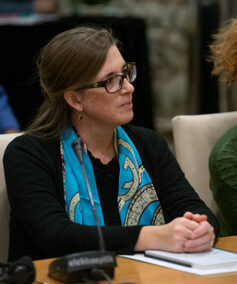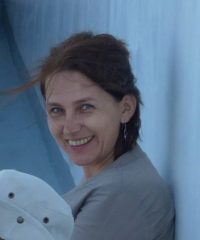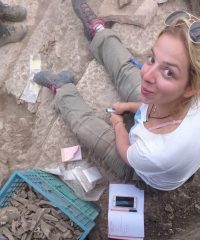Yönetmenler
Christina Luke
Koç UniversityKoç University
Christina Luke
Christina is an anthropological archaeologist who specializes in cultural heritage, ethnography and comparative field archaeology. She is especially interested in landscape studies as they relate to past and present land-use. She has two primary geographic areas of interest, Central America and the eastern Mediterranean, especially the Balkans and western Anatolia. Her current writing projects (articles) focus on Bronze and Iron Age datasets from the Central Lydia Archaeological Survey (CLAS) as well as a work on cultural policy and development in Turkey, 17th c. to present. Her work has been funded by the National Endowment for the Humanities (NEH) and the National Science Foundation (NSF). She is an Associate Professor in the Department of Archaeology and History of Art at Koç University, Istanbul.
Chris Roosevelt
Koç UniversityKoç University
Chris Roosevelt
Chris is a specialist in the archaeology of western Anatolia (Turkey) and specifically that of the Bronze and Iron Age civilizations of the area best known as ancient Lydia. Between 2005 and 2014, Roosevelt co-directed the Central Lydia Archaeological Survey (CLAS) with Luke, a project that investigates long-term patterns of cultural activity, past environmental conditions, and the dynamics between the two. The newest Gygaia Projects initiative is the Kaymakçı Archaeological Project (KAP), begun in 2014. KAP goals include increasing understanding of the emergence and maintenance of an indigenous kingdom situated between the better known spheres of the Hittites and Mycenaeans (in central Anatolia and the Aegean, respectively), through the excavation of a recently discovered and previously unexcavated regional capital of the Middle and Late Bronze Ages. He is a Professor in the Department of Archaeology and History of Art at Koç University in Istanbul and serves as the Director of its Research Center for Anatolian Civilizations (ANAMED).
Müdür Yardımcısı
Tunç Kaner
Koç UniversityKoç University
Tunç Kaner
Tunç serves as the Assistant Excavation Director for the Kaymakçı Archaeological Project, helping to manage daily operations during the field season and administrative processes year round. His work focuses on the second-millennium BCE material culture of western Anatolia with an emphasis on ceramics. His areas of interest and expertise include data management, digital recording technologies, and scientific techniques. He is a PhD student at Koç University.
Caitlin O’Grady
University College LondonUniversity College London
Caitlin O’Grady
Caitlin is a conservator and conservation scientist who specializes in the conservation and analysis of archaeological materials. She acts as Assistant Director for Conservation for the Kaymakçı Archaeological Project, managing the preservation of recovered artifacts and architecture. Her research interests focus on the investigation of material properties and structure in order to relate their roles to long-term preservation of archaeological materials including mudbrick, wall paintings, and ceramics. She is a Lecturer in Conservation at the Institute of Archaeology, University College London.
Peter Pavúk
Charles University in PragueCharles University in Prague
Peter Pavúk
Peter has studied European Prehistory, Medieval Archaeology, and Classical Archaeology. Participation in the Troy excavations (1995–2008) sealed his early interest in the Aegean and western Anatolian archaeology, and specifically second-millennium BCE pottery. He has worked on ceramics from Troy, Bademgediği Tepe (Torbalı), Mikro Vouni (Samothrace), Thermi (Lesbos), Emporio (Chios), and sites in the Kaikos Valley, including Pergamon. Awarded both an Alexander von Humboldt Research Fellowship (2010/11, Heidelberg) and the Michael Ventris Prize (2012, London), he has authored two monographs – one on the MBA/LBA transition in Central Greece (2012, Vienna) and one on Troy VI pottery, chronology, and stratigraphy (2014, Bonn) – and edited four additional volumes. At Kaymakçı, he is working to establish patterns in both typo-chronology and connectivity with surrounding regions.
Catherine Scott
Brandeis UniversityBrandeis University
Catherine Scott
Catherine is a Lecturer at Brandeis University. She is interested in landscapes and the use of space in the Eastern Mediterranean Bronze Age, and in the application of techniques from archaeological science more generally. She has worked on Gygaia Projects initiatives since 2012 and currently serves as field supervisor for Kaymakçı Archaeological Project. Her PhD work focused on using sediment geochemistry to study the use and organization of space at a variety of sites in the valley, including Late Bronze Age Kaymakçı and 20th century Turkish villages, and her ongoing research includes the spatial analysis of fortified sites to develop methodological and theoretical frameworks for interrogating the concept of the “citadel” in western Anatolia.
Kıdemli Araştırmacılar
Canan Çakırlar
Groningen UniversityGroningen University
Canan Çakırlar
Canan is the zooarchaeologist working with the Kaymakçı Archaeological Project. Her research interests include the dispersal and development of husbandry technologies, management of aquatic resources, climatic fluctuations and societal change, provisioning of state-level societies, and human impact on Holocene zoogeography. Her previous studies in western Turkey have focused on Ulucak, Yenibademli, and Troy. Canan’s research has won funding from numerous organizations including the Wenner-Gren Foundation, the Institute for Aegean Prehistory, and the Smithsonian Institution. Her most recent scholarly outputs include a review of the zooarchaeology of western Turkey, soon to appear in the Oxford Handbook of Zooarchaeology, and a special issue of the Journal of Eastern Mediterranean Archaeology and Heritage Studies on urban economies in Bronze and Iron Age Anatolia.
Semih Çelik
Koç UniversityKoç University
Semih Çelik
Semih engages with the Ottoman narratives specific to the Sancak of Saruhan (Manisa) and especially considerations of territoriality, boundaries, and the conservation of wetlands. His current research in the region focuses on the role of waqfs, the Karaosmanoğlu, and citizens in the management of the Lake Marmara Basin from the late 15th century to the early Republican period. He completed his PhD at the European Institute in Florence, Italy in 2017. He currently is a post-doctoral fellow at the Research Center for Anatolian Civilizations (ANAMED) and teaches in the CORE program at Koç University.
Peter Demján
Institute of Archaeology of the Czech Academy of Sciences, PragueInstitute of Archaeology of the Czech Academy of Sciences, Prague
Peter Demján
Peter is an archaeologist and data scientist currently focusing on ways to improve the efficiency, accuracy, and utility of material recording methods and analyses. After receiving his first PhD in Archaeology (2016, Comenius University, Bratislava) he is currently a Researcher at the Institute of Archaeology of the Czech Academy of Sciences, Prague, and working towards a second PhD in Classical Archaeology (Institute of Classical Archaeology, Charles University, Prague). Together with a colleague he designed and developed the Laser-Aided Profiler (along with its associated semi-automated typology software) and is developing new ways to understand and model radiocarbon data from archaeological sites, in association with “RAMSES – Ultra-trace isotope research in social and environmental studies using accelerator mass spectrometry.”.
Müge Ergun
Koç UniversityKoç University
Müge Ergun
Müge Ergun is an archaeologist and archaeobotanist who holds a Ph.D. from Istanbul University’s Department of Prehistory and Paris 1 Panthéon-Sorbonne University Doctoral School of Archaeology (co-tutelle, 2016), and an M.A. from Istanbul University’s Department of Prehistory (2009). Her research focuses on people-plant interactions, plant-based activities in daily and seasonal routines, and their effects on the economic and socio-cultural lives of communities, with a special interest in the beginnings of agriculture and the domestication process in Southwest Asia. She has recently been working on the projects focusing on early Neolithic communities from Central Anatolia (Aşıklı Höyük and Balıklı) and North Cyprus (Tatlısu- Çiftlikdüzü (Akanthou-Arkosykos)), and her work with Kaymakçı includes the study of modern and ancient uses of local shrubs and wood.
Tim Frank
SPSUSPSU
Tim Frank
Tim is an architect, educator, and researcher. With Gygaia Projects he utilizes state-of-the-art performance modeling and simulation tools to evaluate systematically how ancient building systems intensively shaped the behavior of light, heat, and airflow present within the extensive environment. Broadly speaking, he uses these simulation and modeling platforms to expand the purview of the historical survey to account for issues of performance, disclosing strategies used by early populations to organize space in concert with factors dictated by the natural environment. Tim is based in Atlanta, working as an Assistant Professor in the Department of Architecture at SPSU.
Nick Gauthier
Arizona State UniversityArizona State University
Nick Gauthier
Nick is a PhD student in Anthropology at Arizona State University’s School of Human Evolution and Social Change. He is interested in the geoarchaeology, human ecology, and long-term environmental history of the Eastern Mediterranean. His work with Gygaia Projects focuses on modelling past climate, hydrology, and food production strategies to help provide an ecological context for the archaeological record at Kaymakçı.
Zeki Kaya
Middle Eastern Technical UniversityMiddle Eastern Technical University
Zeki Kaya
Zeki leads research on botanical ancient DNA for the Kaymakçı Archaeological Project. He is keenly interested in long-term change in Anatolia and the role of human-plant relationships. His work focuses on the analysis of DNA from carbonized seeds as well as wider considerations of landscape change over time in the Marmara Lake Basin. He also engages with conservation of wetlands in Turkey and serves as the head for the International Union for the Conservation of Nature (IUCN) for Turkey. Zeki is a Professor of Plant Genetics and ancient DNA in the Department of Biological Sciences at the Middle Eastern Technical University.
Hannah Lau
Koç University, ANAMEDKoç University, ANAMED
Hannah Lau
Hannah Lau is an anthropological archaeologist whose research uses zooarchaeological data to examine the relationship between ancient peoples’ animal management practices, the environment, and sociopolitical complexity. She is currently an Environmental Archaeology Fellow at ANAMED. She received her Ph.D. in Archaeology from the University of California, Los Angeles (2016) where her work documented social and economic cooperation and coordination in agropastoral production among inhabitants at the Halaf period site of Domuztepe (ca. 6000–5450 BCE) in southeastern Turkey. Dr. Lau has fieldwork experience at a number of sites in the Near East and South Caucasus, including in the Autonomous Republic of Naxçıvan and in Lerik Province in southeastern Azerbaijan. Her work with Kaymakçı includes the isotopic analyses of animal bones to help explore patterns of animal husbandry.
John (Mac) Marston
Boston UniversityBoston University
John (Mac) Marston
John (Mac) is a specialist for archaeobotanical research at Kaymakçı. In his study of archaeological plant remains – archaeobotany or paleoethnobotany – Marston contributes to questions of agricultural sustainability and environmental and climate change. Mac’s recent interdisciplinary collaborations focus on comparative study of cultural adaptation to environmental and climate change in the past and present. His current field projects include also work at the Iron Age site of Kerkenes, the Bronze Age-Medieval site of Gordion, and the Bronze Age-Medieval site of Ashkelon. Mac’s research has been funded by the American Philosophical Society, Boston University, Council of American Overseas Research Centers, and the US National Science Foundation.
Jana Mokrišová
University of MichiganUniversity of Michigan
Jana Mokrišová
Jana is a PhD candidate at the University of Michigan. Her research focuses on cultural dynamics and mobility at the dawn of the Late Bronze Age and during the Early Iron Age in Western Anatolia. In addition to acting as an excavation area supervisor at Kaymakçı, Jana is conducting a study of the use of mudbrick at the site.
Funda Özdemir Değirmenci
Ahi Evran UniversityAhi Evran University
Funda Özdemir Değirmenci
Funda works closely with Professor Kaya. She is preparing a large project that will explore ancient DNA of carbonized seeds from Kaymakçı as well as the application of environmental DNA for the Marmara Lake Basin. Her work focuses on the integration between holistic environmental archaeology and ancient DNA in landscape studies. She is currently a post-doc at in the Department of Biological Sciences at the Middle Eastern Technical University.
Magda Pieniążek
Tübingen UniversityTübingen University
Magda Pieniążek
Magda is an archaeologist specializing in the Bronze Age Aegean, western Anatolia, and Black Sea areas. Her research has included settlement archaeology and architecture and currently focuses on jewelry and other “small finds,” from sites such as Troy, Alalakh, Thessaloniki Toumba, and other Aegean and Anatolian sites, and what they can reveal about exchange mechanisms, sociopolitical change, economy, and the development of prehistoric technologies as well the meanings and functions of valuable objects. She finished her PhD in Tübingen, was awarded postdoctoral fellowships from the Troy Foundation and European Commission, and has taught in both Tübingen and Heidelberg. In addition to her work elsewhere, she is the specialist for “small finds,” such as personal ornaments and various kinds of tools, with the Kaymakçı Archaeological Project.
Bradley Sekedat
UC DavisUC Davis
Bradley Sekedat
Bradley was Gygaia Project’s Assistant Director for Survey. He is a specialist in survey methodology and Roman-period landscape archaeology, with an interest in landscapes, settlement dynamics, and governance. His research also explores ancient stone-working technologies, especially in the marble quarries of the Marmara Lake basin. Sekedat is a Lecturer in Writing at the University of California, Davis.
Lisansüstü Öğrenci Araştırmacılar
Dalila Alberghina
Koç UniversityKoç University
Dalila Alberghina
Dalila’s research focuses on materiality and the human past. Her current work explores metallurgy in second-millennium BCE western Anatolia. The role of ritual and production as an integrated relationship is among the foci of her research. She is also engaged in the excavations at Kaymakçı and the born-digital technologies integrated into the recovery and analysis of the past. Her interests also include food and society as well as engagement with the humanities in education. She is a PhD candidate at Koç University.
Şengül Fındıklar
Koç UniversityKoç University
Şengül Fındıklar
Şengül Fındıklar investigates the zooarchaeological worlds of western Anatolia. Her research focuses on animal-human relationships throughout the Bronze Age. Her interests include ritual, political economy and environmental archaeology. At Kaymakçı she manages the processing of zooarchaeological remains throughout the field season and assists with training programs. Her detailed research explores the role of cattle at Kaymakçı. She is a MA student at Koç University.
Ebru Kaner
Koç UniversityKoç University
Ebru Kaner
Ebru investigates monumental architecture in the Late Bronze Age western Anatolia. Her current work at Kaymakçı explores the social contexts of the fortification system. As a trench supervisor, she also engages closely with the application of born-digital technologies in the excavation and recovery of material culture from Kaymakçı. She is completing her PhD at Istanbul University and serves as the Laboratory Supervisor in the Department of Archaeology and History of Art at Koç University.
Emanuel Moss
CUNY Graduate CenterCUNY Graduate Center
Emanuel Moss
Emanuel is a PhD candidate at the CUNY Graduate Center. He is interested in the role of changing visualization technologies in the production of knowledge, particularly in archaeological and heritage contexts. He works with Gygaia Projects as a Spatial Data and Digital Technologies Specialist, focusing on spatial data management and the development of 3-dimensional recording and visualization techniques.
Nami Shin
Koç UniversityKoç University
Nami Shin
Nami Shin explores the archaeobotanical worlds of western Anatolia. Her work at Kaymakçı focuses on the excavation, recovery and identification of plant remains, usually in the form of carbonized seeds, such as grape, barely, wheat, lentil and bitter vetch. She is active in training programs for new participants. Her research foci and collaborations include partnerships with Beycelsultan and Troy. She is a PhD student at Koç University.
Francesca Slim
Groningen UniversityGroningen University
Francesca Slim
Francesca has been with the Kaymakçı Archaeological Project for many years. Her MA work at Groningen focused on the role of pigs and society using the Kaymakçı material. For her PhD research, she is expanding this focus to greater western Anatolia and the Aegean, still incorporating the Kaymakçı material. Her contributions to Kaymakçı also include analysis of the entire zooarchaeological assemblage and geomorphometric analyses. She is a PhD student at Groningen University.
Orhan Yavuz
Koç UniversityKoç University
Orhan Yavuz
Orhan comes to Kaymakçı with a passion for Bronze Age Anatolia and especially the application of ancient human DNA studies. His undergraduate degree in physics from the University of Pennsylvania gives him critical background to engage in this work, and he collaborates with Professor of Computational Biology Mehmet Somel at the Middle Eastern Technical University. Orhan is a MA student at Koç University.

























